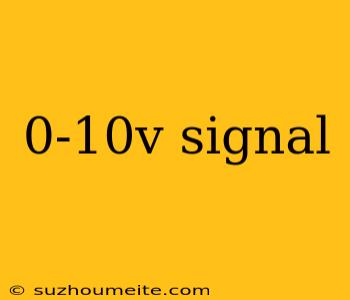0-10V Signal: Understanding the Fundamentals
In the world of electronics and industrial automation, signals play a crucial role in communicating information between devices. One of the most commonly used signal types is the 0-10V signal. In this article, we will delve into the basics of 0-10V signals, their applications, and how they are used in various industries.
What is a 0-10V Signal?
A 0-10V signal is a type of analog signal that ranges from 0 volts to 10 volts. It is a continuous signal that varies in voltage level to represent different values or states. The 0-10V signal is often used to transmit information from a sensor or transducer to a controller or processing unit.
How 0-10V Signals Work
A 0-10V signal is generated by a device such as a sensor, transducer, or converter. The device converts a physical parameter, such as temperature, pressure, or light, into a corresponding voltage signal. The voltage signal is then transmitted to a receiving device, which interprets the signal and takes appropriate action.
For example, a temperature sensor might output a 0-10V signal that corresponds to a temperature range of 0°C to 100°C. If the temperature is 50°C, the sensor would output a voltage signal of 5V.
Applications of 0-10V Signals
0-10V signals have a wide range of applications in various industries, including:
Process Control
0-10V signals are widely used in process control systems to monitor and control parameters such as temperature, pressure, flow rate, and level.
Industrial Automation
0-10V signals are used in industrial automation systems to control motors, valves, and other devices.
HVAC Systems
0-10V signals are used in heating, ventilation, and air conditioning (HVAC) systems to control temperature, humidity, and air flow.
Medical Devices
0-10V signals are used in medical devices such as patient monitors, ventilators, and dialysis machines.
Advantages of 0-10V Signals
0-10V signals have several advantages, including:
Easy to Implement
0-10V signals are easy to implement and require minimal components.
Low Power Consumption
0-10V signals require low power consumption, making them suitable for battery-powered devices.
High Resolution
0-10V signals can provide high resolution and accuracy, making them suitable for precision applications.
Noise Immunity
0-10V signals are relatively immune to noise and interference, making them reliable in noisy environments.
Conclusion
In conclusion, 0-10V signals are a fundamental component in many industrial and commercial applications. They offer a reliable and efficient way to transmit information between devices. Understanding the basics of 0-10V signals is essential for designing and implementing effective control systems. By recognizing the advantages and applications of 0-10V signals, engineers and technicians can create more efficient and reliable systems.
